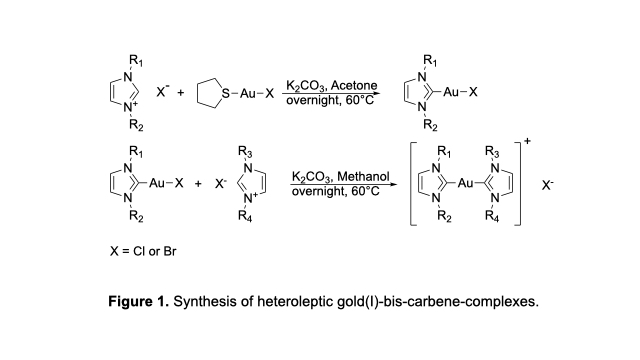Poster Presentation 21st International Conference on Biological Inorganic Chemistry 2025
Synthesis of functionalised imidazolium salts and their corresponding gold(I)-bis-carbene-complexes (#481)
Gold(I)-based compounds such as Auranofin have long been used to treat rheumatoid arthritis but were more recently shown to be promising anticancer drugs.1-2 N-heterocyclic-carbenes have become ubiquitous ligands in bioorganometallic chemistry, due to their ease of preparation and enormous structural variety. While gold(I)-mono-carbene-complexes are well known, gold(I)-bis-carbene-complexes are rarely encountered in the literature. By using a modified version of the classical weak-base route,3 we were able to prepare a wide range of homo- and heteroleptic gold(I)-bis-carbene-complexes with up to four different N-substituents.
Using this method, a library of homo- and heteroleptic gold(I)-bis-carbene-complexes was prepared and fully characterized using NMR spectroscopy, mass spectrometry and single crystal X-ray diffraction. (Figure 1). The choice of N-substituents allowed us to impose specific biological or chemical properties such as fluorescence, accumulation in cellular targets and solubility in water. In vitro cytotoxicity of selected complexes in HepG2 cells was studied using a metabolic activity assay. The data shows that the gold(I) complexes are more active than the respective imidazolium salts, with IC50 values in the mM range. Depending on the nature of the substituents, different activity was observed. In some cases, the bis-carbene-complexes were more active, whilst in other cases the activity of the mono-carbene species was superior.

- A. Erxleben, Curr. Med. Chem. 2018, 26, 694-728.
- A. Citta, E. Schuh, F. Mohr, A. Folda, M. L. Massimino, A. Bindoli, A. Casini, M. P. Rigobello, Metallomics, 2013, 5, 1006-1015.
- A. Collado, A. Gómez-Suárez, A. R. Martin, A. M. Z. Slawin, S. P. Nolan, Chem. Commun. 2013, 49, 5541-5543.